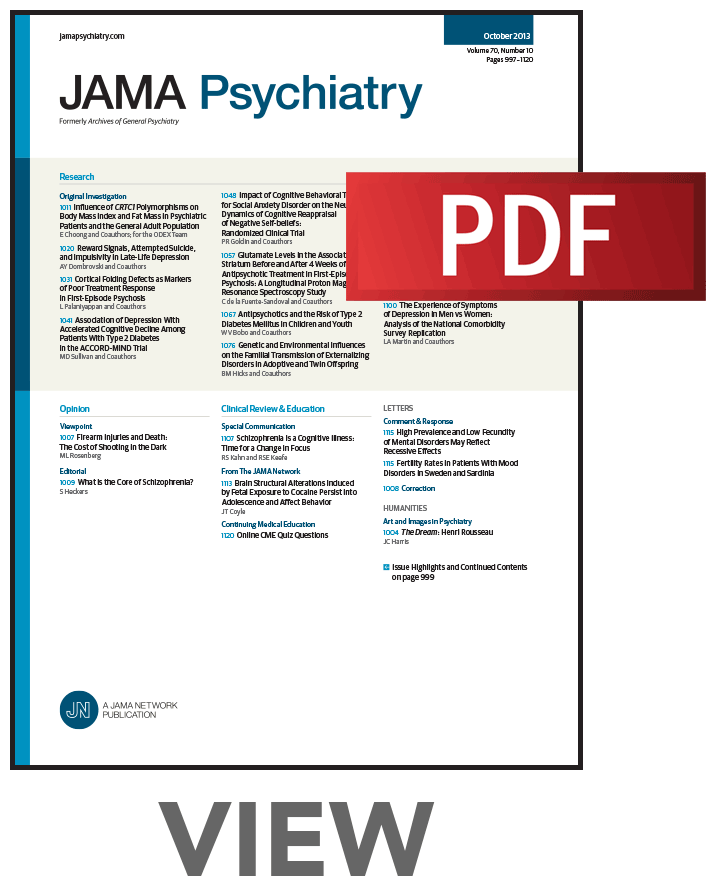能量稳态在抑郁症病理生理中的作用及其异质性。
IF 17.1
1区 医学
Q1 PSYCHIATRY
引用次数: 0
摘要
能量稳态失调可能构成重度抑郁症(MDD)异质性病理生理的一个模块,潜在地表现为一种独特的症状特征。目的探讨参与能量稳态调节的代谢、内感受和动机通路的共同遗传倾向是否与特定MDD症状的表达有关。设计、环境和参与者本研究使用了来自大型全基因组关联研究的汇总数据和来自2个前瞻性精神病学队列的个体水平数据,即CoLaus|PsyCoLaus(基于人群的)和荷兰抑郁和焦虑研究(NESDA;临床富集)队列。从2023年5月到2024年11月,数据被检索和分析。通过半结构化的诊断访谈确定重度抑郁症的终生诊断。样本包括来自CoLaus的1407例MDD病例和2020例对照,以及来自NESDA的1803例MDD病例和266例对照。基因组结构方程模型被用于模拟一个独特的潜在因素,该因素捕获了代谢和内感受性信号(体重指数、甘油三酯、空腹血糖、c反应蛋白、瘦素)和动机(快感缺乏)过程中共享的共同遗传倾向。从这一潜在因素出发,推导出一个多基因评分(PGS),索引可能参与能量稳态调节的性状的共同遗传倾向性。主要结局和测量方法参与者在重度抑郁症期间共有15种抑郁症状。结果1407例重度抑郁症患者中,女性占66.2%;中位出生年份[YOB], 1956年)和2020年对照(44.3%女性;中位年龄,1955年),来自科劳斯,精神病科劳斯,1803例MDD(68.3%女性;平均年龄,1962年)和266个对照组(56.0%女性;中位YOB, 1960),多个显著的双向孟德尔随机化估计和遗传相关性(r = 0.11-0.81)表明所选性状之间具有共同的遗传基础,并通过基因组结构方程模型将其建模为潜在的稳态因素。在队列数据中,与两组对照相比,MDD病例中潜在体内平衡因子的PGS指数(错误发现率,<5%)显著高于食欲增加和嗜睡症(食欲增加优势比[OR], 2.25 [95% CI, 2.00-2.53];p = 9.03 × 10-41;睡眠过多OR, 1.22 [95% CI, 1.10-1.35];P = 1.15 × 10-04)和其他MDD病例(食欲增加OR, 1.88 [95% CI, 1.63-2.18];p = 2.38 × 10-17;睡眠过度OR, 1.18 [95% CI, 1.05-1.33];p = 5.80 × 10-03)。结论和相关性本研究确定了抑郁症病理生理的一个模块,其特征是能量稳态改变,并与反映能量节约和摄入反应的特定症状的表达相关。这些发现可用于识别代谢风险较高的抑郁症患者,并为开发靶向治疗铺平道路。本文章由计算机程序翻译,如有差异,请以英文原文为准。
The Role of Energy Homeostasis in Depression Pathophysiology and Its Heterogeneity.
Importance
Energy homeostatic dysregulation may constitute 1 module of the heterogeneous pathophysiology of major depressive disorder (MDD), potentially manifesting as a distinctive symptom profile.
Objective
To test whether the shared genetic liability of metabolic, interoceptive, and motivational pathways involved in energy homeostasis regulation is associated with the expression of specific MDD symptoms.
Design, Setting, and Participants
This study used summary-level data from large genome-wide association studies and individual-level data from 2 prospective psychiatric cohorts, the CoLaus|PsyCoLaus (population-based) and Netherlands Study of Depression and Anxiety (NESDA; clinically enriched) cohorts. Data were retrieved and analyzed from May 2023 through November 2024. A lifetime diagnosis of MDD was ascertained with semistructured diagnostic interviews. The sample comprised 1407 MDD cases and 2020 controls from CoLaus|PsyCoLaus and 1803 MDD cases and 266 controls from NESDA.
Exposures
Genomic structural equation modeling was applied to model a unique underlying factor capturing the common genetic liability shared among metabolic and interoceptive signals (body mass index, triglycerides, fasting glucose, C-reactive protein, leptin) and motivational (anhedonia) processes. From this underlying factor, a polygenic score (PGS) was derived, indexing the shared genetic liability of traits potentially involved in energy homeostasis regulation.
Main Outcomes and Measures
A total of 15 depressive symptoms endorsed by participants during MDD.
Results
Among 1407 MDD cases (66.2% female; median year of birth [YOB], 1956) and 2020 controls (44.3% female; median YOB, 1955) from CoLaus|PsyCoLaus and 1803 MDD cases (68.3% female; median YOB, 1962) and 266 controls (56.0% female; median YOB, 1960) from NESDA, multiple significant bidirectional mendelian randomization estimates and genetic correlations (r = 0.11-0.81) indicated a shared genetic basis between the selected traits, which was modeled as a latent homeostatic factor with genomic structural equation modeling. In cohort data, the PGS indexing the latent homeostatic factor was significantly (false discovery rate, <5%) higher in MDD cases endorsing appetite increase and hypersomnia when contrasted with both controls (appetite increase odds ratio [OR], 2.25 [95% CI, 2.00-2.53]; P = 9.03 × 10-41; hypersomnia OR, 1.22 [95% CI, 1.10-1.35]; P = 1.15 × 10-04) and other MDD cases (appetite increase OR, 1.88 [95% CI, 1.63-2.18]; P = 2.38 × 10-17; hypersomnia OR, 1.18 [95% CI, 1.05-1.33]; P = 5.80 × 10-03).
Conclusions and Relevance
This study identified a module of depression pathophysiology characterized by altered energy homeostasis and associated with the expression of specific symptoms reflecting energy saving and intake responses. These findings could be used to identify patients with depression at higher metabolic risk and could pave the way for the development of targeted treatments.
求助全文
通过发布文献求助,成功后即可免费获取论文全文。
去求助
来源期刊

JAMA Psychiatry
PSYCHIATRY-
CiteScore
30.60
自引率
1.90%
发文量
233
期刊介绍:
JAMA Psychiatry is a global, peer-reviewed journal catering to clinicians, scholars, and research scientists in psychiatry, mental health, behavioral science, and related fields. The Archives of Neurology & Psychiatry originated in 1919, splitting into two journals in 1959: Archives of Neurology and Archives of General Psychiatry. In 2013, these evolved into JAMA Neurology and JAMA Psychiatry, respectively. JAMA Psychiatry is affiliated with the JAMA Network, a group of peer-reviewed medical and specialty publications.
 求助内容:
求助内容: 应助结果提醒方式:
应助结果提醒方式:


